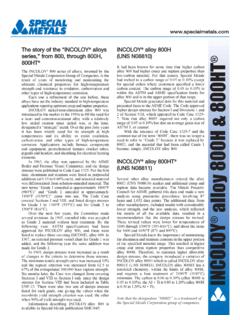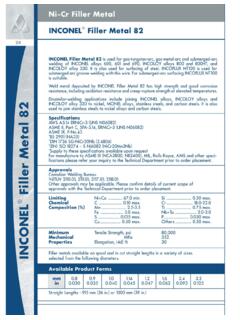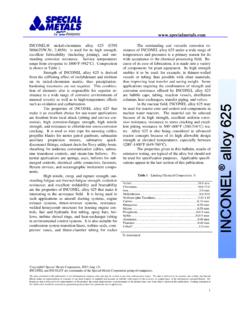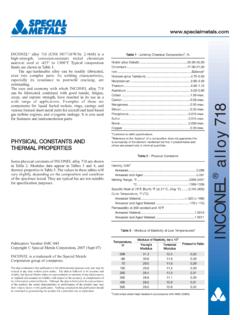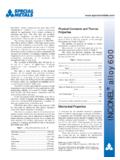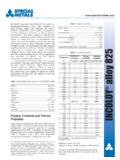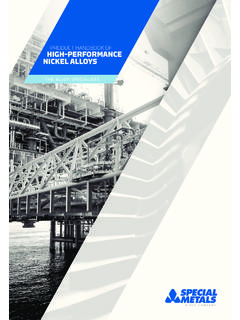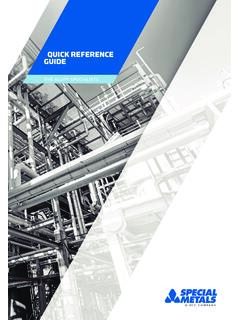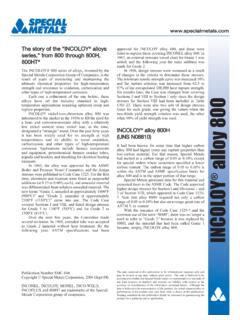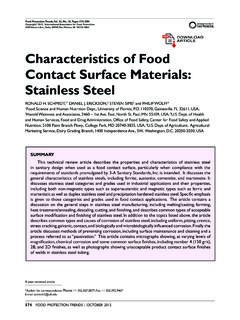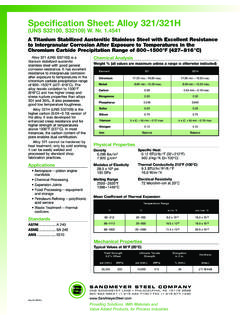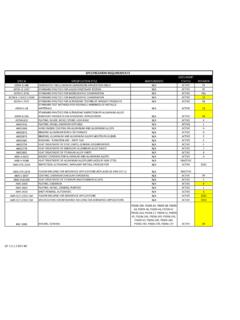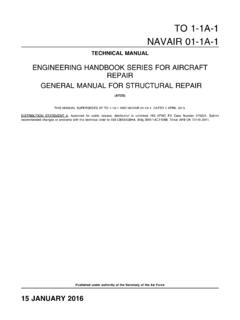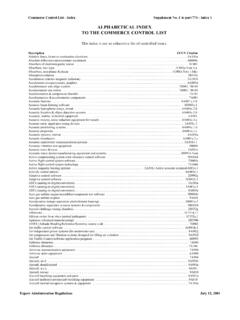Transcription of www.specialmetals
1 INCOLOY alloy 825 (UNS N08825 ) is a Table 2 - Physical Constants nickel-iron-chromium alloy with additions of molybdenum, copper, and titanium . The alloy's Density, lb/in3 .. chemical composition, given in Table 1, is designed to Mg/m3 .. provide exceptional resistance to many corrosive Melting Range, F ..2500-2550. environments. The nickel content is sufficient for C ..1370-1400. resistance to chloride-ion stress-corrosion cracking. The Specific Heat, Btu/lb F .. nickel, in conjunction with the molybdenum and J/kg C ..440. copper, also gives outstanding resistance to reducing Curie Temperature, F ..<-320. environments such as those containing sulfuric and C ..<-196. phosphoric acids. The molybdenum also aids resistance Permeability at 200 oersted ( kA/m).
2 To pitting and crevice corrosion. The alloy's chromium INCOLOY alloy 825. content confers resistance to a variety of oxidizing substances such as nitric acid, nitrates and oxidizing Table 3 - Thermal Properties salt. The titanium addition serves, with an appropriate heat treatment, to stabilize the alloy against Coefficient of Thermal Electrical Temperature sensitization to intergranular corrosion. Expansiona Conductivity Resistivity The resistance of INCOLOY alloy 825 to general F 10-6in/in F Btu-in/ft2 h F ohm circ mil/ft and localized corrosion under diverse conditions gives -250 - 55 - the alloy broad usefulness. Applications include -200 - 59 - chemical processing, pollution control, oil and gas -100 - 66 - recovery, acid production, pickling operations, nuclear 0 - - fuel reprocessing, and handling of radioactive wastes.
3 Applications for alloy 825 are similar to those for 78 - 678. INCOLOY alloy 020. 100 - 680. 200 687. 400 710. Table 1 - Limiting Chemical Composition, % of INCOLOY alloy 825. 600 728. 800 751. Nickel .. 1000 761. min. 1200 762. 1400 765. Molybdenum .. 1600 775. Copper .. 1800 - 782. 2000 - - 793. Carbon .. max. C m/m C W/m C m Manganese .. max. Sulfur .. max. -150 - - Silicon .. max. -100 - - max. 0 - - 25 - 100 Physical Constants and Thermal 200 300 Properties 400 Some physical constants for INCOLOY alloy 825 are 500 listed in Table 2. Values for thermal expansion, thermal 600 conductivity, and electrical resistivity at various 700 temperatures are in Table 3. Modulus of elasticity and 800 Poisson's ratio over a range of temperatures are given in 900 - Table 4.
4 Modulus values, which were determined 1000 - - dynamically, were used to compute Poisson's ratio. a Mean coefficient of linear expansion between 80 F (27 C) and temperature shown. The data contained in this publication is for informational purposes only and may be revised at any time without prior notice. The data is believed to be Publication Number SMC-030. accurate and reliable, but Special Metals makes no representation or warranty of Copyright Special Metals Corporation, 2004 (Sept 04). any kind (express or implied) and assumes no liability with respect to the accuracy or completeness of the information contained herein. Although the data is believed to be representative of the product, the actual characteristics or INCOLOY, INCONEL, INCO-WELD and 686 CPT are performance of the product may vary from what is shown in this publication.
5 Trademarks of the Special Metals Corporation group of Nothing contained in this publication should be construed as guaranteeing the product for a particular use or application. companies. INCOLOY alloy 825. Mechanical Properties INCOLOY alloy 825 has good mechanical properties from cryogenic temperatures to moderately high temperatures. Exposure to temperatures above about 1000 F (540 C) can result in microstructural changes (phase formation) that significantly lower ductility and impact strength. For that reason, the alloy is not normally used at temperatures where creep-rupture properties are design factors. Tensile properties at room temperature are listed in Table 5. As indicated, the alloy can be strengthened substantially by cold work.
6 High-temperature tensile properties are shown in Figure 1. The tests were conducted on cold-drawn rod of (19- mm) diameter annealed at 1725 F (940 C)/1 hr. Compressive yield strength of the alloy is similar to tensile yield strength. Tests on annealed rod of (25-mm). diameter produced a compressive yield strength ( offset) of 61,400 psi (423 MPa) compared with a tensile yield strength of 57,500 psi (396 MPa). Ultimate tensile strength of the material was 104,500 psi (720 MPa). INCOLOY alloy 825 has good impact strength at room temperature and retains its strength at cryogenic temperatures. Table 6 gives the results of Charpy keyhole tests on plate. Table 4 - Modulus of Elasticity (Hot Rolled and Annealed Plate) Table 5 - Typical Room-Temperature Tensile Properties Young's Shear Yield Strength Temperature Form and Tensile Strength Elongation, Modulus Modulus Poisson's ( Offset).
7 Ratio Condition %. F 103 ksi 103 ksi ksi MPa ksi MPa Tubing, Annealed 112 772 64 441 36. 100 Tubing, Cold Drawn 145 1000 129 889 15. 200 Bar, Annealed 100 690 47 324 45. 300 Plate, Annealed 96 662 49 338 45. 400 Sheet, Annealed 110 758 61 421 39. 500 600 Table 6 - Charpy Keyhole Impact Strength of Plate 700 Temperature Impact Strengtha 800 Orientation 900 F C ft-lb J. 1000 Room Room Longitudinal 107. 1100 Transverse 113. 1200 -110 -43 Longitudinal 106. 1300 Transverse 106. 1400 -320 -196 Longitudinal 91. 1500 Transverse 97. 1600 -423 -253 Longitudinal 92. 1700 Transverse 92. 1800 a Average of three tests. Young's Shear Temperature, C. Temperature Poisson's 0 100 200 300 400 500 600 700 800 900 1000. Modulus Modulus 120.
8 Ratio C GPa GPa 20 196 76 100 700. Tensile Strength Elongation, %. 100 192 75 600. 200 187 72 80. Stress, MPa 300 181 70 500. 400 174 68 60 400. 500 168 65 Elongation Stress, ksi 300. 600 162 61 40. 700 154 57 200. 800 142 53 20 Yield Strength ( Offset) 100. 900 131 49 1000 118 44 0 0. 0 200 400 600 800 1000 1200 1400 1600 1800 2000. Temperature, F. Figure 1. High-temperature tensile properties of annealed bar. Indicates the typical usage range. 2. INCOLOY alloy 825. Corrosion Resistance The outstanding attribute of INCOLOY alloy 825 is its high level of corrosion resistance. In both reducing and oxidize environments, the alloy resists general corrosion, pitting, crevice corrosion, intergranular corrosion, and stress-corrosion cracking.
9 Some environments in which INCOLOY alloy 825 is particularly useful are sulfuric acid, phosphoric acid, sulfur- containing flue gases, sour gas and oil wells, and sea water. For details on the corrosion resistance of alloy 825, refer to Special Metals publication Restistance to Aqueous Corrosion , on the website, Fabrication INCOLOY alloy 825 products are heat treated during manufacturing at the mill to develop the optimum combination of stabilization, corrosion resistance, mechanical properties, and formability. To maintain these properties during fabrication, subsequent anneals should be performed between 1700 to 1800 F (930 to 980 C) followed by rapid air cooling or water quenching. Heat treatment in the lower end of the range is acceptable for stabilization.
10 However, annealing at temperatures in the higher end of this range may be preferred for softness and grain structure for forming and deep-drawing while maintaining corrosion resistance. Quenching is usually not necessary for parts of thin cross section ( , sheet, strip and wire), but may be desired to avoid sensitization in products of heavier cross section. General procedures for heating, forming, pickling, and finishing are found in the SMC bulletin Fabricating . Welding, brazing, and soldering techniques are discussed in Joining . These bulletins are available on the website Hot and Cold Forming The hot-working range for INCOLOY alloy 825 is 1600 to 2150 F (870 to 1180 C). For optimum corrosion resistance, final hot working should be done at temperatures between 1600 and 1800 F (870 and 980 C).
